Welcome to Part 2 of Cinema Smack’s 31 Days of Horror! If you’ve yet to read Part 1, you can do so by clicking here.
This is a feature that’s just too big for one posting so we’re separating our list into multiple for better reader accessibility. As we mentioned in Part 1, this list isn’t meant to be a “greatest hits” or history of horror. It’s a collection of classics, favorites, underrated gems, and cult films that we think everyone should seek out. Obviously, we aren’t able to include every film on this list so a number of films were omitted to make room for some that may not get the attention they deserve.
With that, let’s get back to the horror!
October 11th: The Witch (2015)
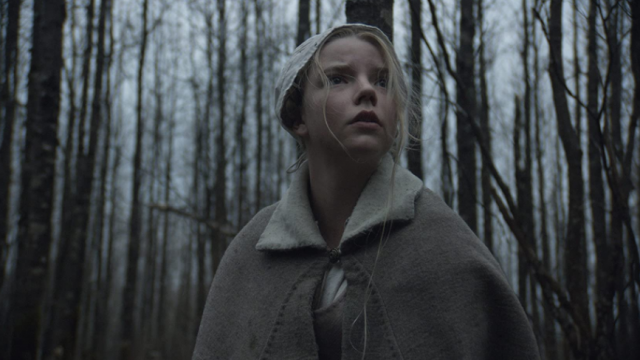
While our last entry on this list flirts with the idea of witches and covens, the debut feature from Robert Eggers is a more traditional, yet undeniably satisfying, approach. 2016’s The Witch focuses on a family of settlers in 1630’s New England who are banished from a Puritan Plymouth Colony over a religious dispute. The family, headed by William (Ralph Ineson), relocate and build a farm near a forest. Tragedy strikes when baby Samuel suddenly disappears while William’s daughter, Thomasin (Anya Taylor-Joy), is playing peekaboo with him. Tension rises in the family’s ranks with William’s young twins, Jonas (Lucas Dawson) and Mercy (Ellie Grainger), accusing Thomasin of being a witch while their mother, Katherine (Kate Dickie), is emotionally shattered. With the farm failing, further tragedies occurring, and evidence of witchcraft and black magic piling up, the family is torn apart and may not be able to survive such a wrath.
Something that’s really surprising about The Witch is how the film handles its characters. All of the characters are quite cold and callous. Yet, you still feel for them and become invested in their lives. There’s nothing especially likable or relatable about any of them. It’s just that their situation is so dire that you can’t help but sympathize. While you could make a case for Ralph Ineson’s William, it’s Anya Taylor-Joy, in her first credited film role, that’s the film’s biggest standout. Thomasin’s not quite the punching bag that Mia Farrow’s Rosemary is in Rosemary’s Baby but she does take much of the family’s punishment. She’s not completely innocent as she does fuel her siblings’ speculation of her being a witch. However, she becomes the family’s scapegoat thanks to Samuel disappearing on her watch. Her treatment largely fuels the complete dismantling of the family unit and makes the film an unnerving watch from start to finish.
Like the aforementioned Rosemary’s Baby, The Witch is another excellent slow burn arthouse horror film. There’s a haunting atmosphere throughout the entire film with isolation and a sense of dread consuming every scene. The barren landscape gives the feeling that the family doesn’t necessarily belong there and the psychological torture they soon face is evidence of that. In his feature film debut, Robert Eggers maintains a deliberate pacing with eerie imagery and a moody, ambient soundtrack that chills you to the bone. Given his work on films like The Witch and 2019’s The Lighthouse, Eggers is a rising name in the horror genre and a wholly unique and original filmmaker. The Witch is often credited as one of the best horror films of the 2010’s and we really can’t argue that given the story and mood that Eggers expertly crafts.
October 12th: Evil Dead II (1987)
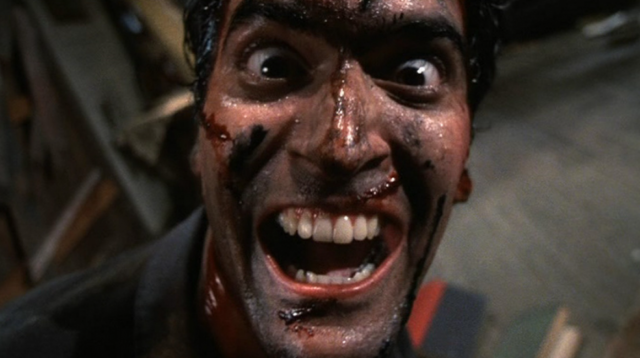
Hold on a second. What’s a sequel doing here? Well, forget that roman numeral at the end of the title because it’s completely irrelevant. Evil Dead II from writer/director Sam Raimi sees Ashley J. Williams (Bruce Campbell) have another go-round with the evil forces in the forest surrounding a small cabin. Ash and his girlfriend, Linda (Denise Bixler), travel to the cabin where, before long, Linda’s possessed by said forces. Ash survives the onslaught from Linda but must then fight back against his own possession while holing up with a group of strangers in the cabin and battling the murderous deadites within.
For those who may not be aware, yes, Evil Dead II follows up Raimi’s 1981 cult splatstick classic, The Evil Dead. The long running question about the film, though, has always been, “Is Evil Dead II actually a sequel or is it a remake?” After all, most of the events that happen in the film are a new spin on something that happened in the 1981 film. This version of Ash doesn’t seem to have any memory of the cabin in the woods or the horrors he and his friends previously faced. Items like the Necronomicon (AKA the Book of the Dead) and the Kandarian Dagger play a role in both films but, again, Ash doesn’t seem to remember their purpose from his first encounter at the cabin. His girlfriend in both films is even named Linda although both are played by different actresses. For the sake of this review, we’re considering Evil Dead II to be more of a remake than a sequel. It’s a do-over that, frankly, exceeds the heights of the original film and sets up the plot going forward for both a 1992 sequel, Army of Darkness, and the sequel television series, Ash vs Evil Dead, which ran for three seasons.
Unlike all of the previous films featured in our 31 Days of Horror, Evil Dead II is the first one that can be described as being “fun.” This is horror comedy at its finest with plenty of physical slapstick comedy, amusingly terrifying creature effects, and, of course, gore. Bruce Campbell, as always, is phenomenal as the fan favorite, Ash Williams. He really brings the character to live in this film moreso than in the first with his memorable catchphrases and bad ass action hero swagger. There’s a reason that the character has become such a horror icon and the true start of that came in Evil Dead II. Seeing Campbell’s Ash dismember his deadite girlfriend and fight with his own possessed hand is simply classic at this point and breathed life into a beloved character that has endured for decades. What else can we really say about Evil Dead II that hasn’t been said before? It’s a comedic horror masterpiece that paved the way for other bloodsoaked and wildly entertaining films like Dead Alive, Shaun of the Dead, and The Cabin in the Woods. Whether the original, this sequel/remake, the TV show, or even the 2013 reboot is more your cup of tea, anything Evil Dead is essential viewing during the Halloween season. For us though, the gold standard of this franchise is the 1987 version.
October 13th: Audition (1999)
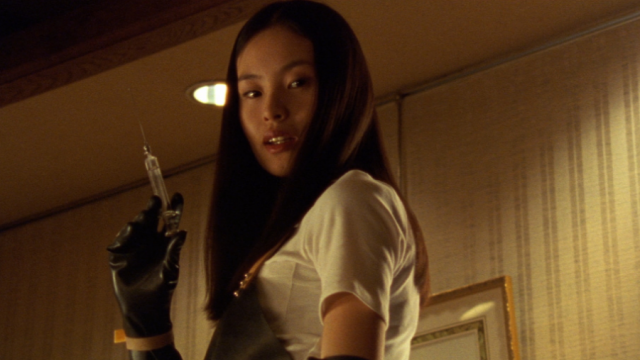
Around the turn of the century, there was something brewing in Japan when it came to the horror genre. With films like Ringu, Dark Water, and Ju-on terrifying audiences with their mystery filled ghost stories, the United States quickly took notice and began pumping out American remakes to a fair amount of success. However, there’s one film from this era that has yet to get the remake treatment while still influencing perhaps an entire subgenre of horror. Takashi Miike’s 1999 film, Audition, centers on recent middle aged widower Shigeharu Aoyama (Ryo Ishibashi) as he decides to get back in the dating game. Aoyama’s friend, film producer Yasuhisa Yoshikawa (Jun Kunimura), suggests they hold a faux casting audition to find the woman of Aoyama’s dreams. Here, young Asami Yamazaki (Eihi Shiina) catches his eye and he quickly falls in love with her. However, Asami’s references, acquaintances, and her past in general are a mystery with all connections to her resulting in dead ends. Aoyama is mostly blind to this which ultimately has him discovering something dark and sinister about Asami.
Audition is another one of those “different kind of horror films” because, for the majority of the film’s runtime, it really isn’t horror. Instead, it’s mostly a drama with Aoyama and Asami’s budding relationship at its heart. Aoyama is a likable character who’s not just looking for looks or sex appeal while holding the fake audition. He’s actually looking for someone to spend his life with. Asami appears to be the perfect woman for him despite her mysterious background and innocently shy demeanor. The two have a somewhat intense relationship prior to the atrocities to come with the film feeling more reminiscent to neo-noir titles like Body Heat or Basic Instinct than anything from the horror genre. It’s only after Aoyama and Asami’s relationship reaches a fever pitch that the true horror begins.
While we won’t spoil any of the film’s best scenes, know that Audition isn’t for the faint of heart. There’s a level of realism to the violence that, although relatively tame when compared to some films, still makes you cringe. There’s an uncomfortable vibe throughout the whole last act that just isn’t felt in the majority of horror films. This is what truly sets Audition apart from not only its contemporaries but most horror titles in general. The film has largely been credited as a pioneer of the “torture porn” subgenre and, again, it’s relatively tame when compared to something like Eli Roth’s Hostel. That being said though, Audition leaves a much stronger impression because of how the film’s characters interact and by how real the violence towards them feels. Audition is an engaging, yet visceral, experience that no horror fan should be without.
October 14th: Creepshow (1982)
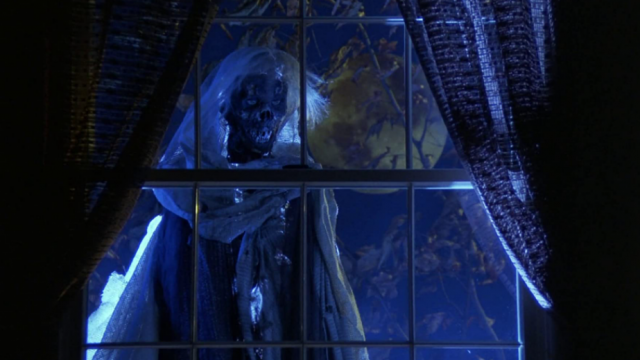
Just a couple of days ago, we talked about having a little fun in the horror genre in our review of Evil Dead II. The 1980’s were a decade rife with levity in horror with films like Evil Dead, Gremlins, and Beetlejuice maintaining a playful tone yet still giving genre fans the thrills they crave. While all these films are iconic in their own right, perhaps the most definitive horror/comedy/camp/cult film of all is 1982’s Creepshow. Written by horror master Stephen King and directed by the king of the zombie flick, George A. Romero, Creepshow is an anthology film with five short stories bookended by a prologue and epilogue. The beginning of the film sees a young boy, Billy, played by King’s own son, Joe Hill, creator of the popular Locke & Key comic book series, as he’s scolded by his father, Stan (Tom Atkins), for reading comic books. From here, the short stories about Father’s Day cake, rapidly spreading vegetation, a vicious man exacting his revenge on his wife and her lover, a mysterious crate, and a cockroach infestation all play out before things wrap up with Billy and his father.
To go into detail about each of the short stories would be foolish in one of these short reviews. Basically, each tale features horrific and torturous scenarios for each of the characters. It should be stated that Creepshow gets a bit long in the tooth by the time you’re hitting stories like “The Crate” and especially “They’re Creeping Up On You” but none of them are bad. It’s just that the most memorable ones of the bunch are in its first half. Specifically, “The Lonesome Death of Jordy Verrill,” starring Stephen King himself, and “Something to Tide You Over” represent the high points of Creepshow. Each short is unnerving in its own way but there’s also plenty to laugh at with the performances and scenarios that the characters find themselves in.
What really puts Creepshow over the top, though, is its insane cast and crew. As far as acting, Romero and King didn’t only stick to horror talent. Genre regulars like Tom Atkins, Adrienne Barbeau, Tom Savini, and Stephen King mingle with non-genre names like Ed Harris, Hal Holbrook, Ted Danson, and even Leslie Nielsen over the course of the film. Then, there’s obviously the presence of icons like Romero and King. Couple that with the special makeup effects of horror wizard Tom Savini as he provides all of the monsters with a unique look that’s signature Savini. The film is essentially a dream team of talent and, even though it’s maybe a little too long as it clocks in at two hours, it’s an absolute spectacle for every second of its runtime. The overall tone and atmosphere of Creepshow just screams “Halloween” and it’s no surprise that this anthology has become a staple in horror fans’ fall rotation.
October 15th: Black Christmas (1974)
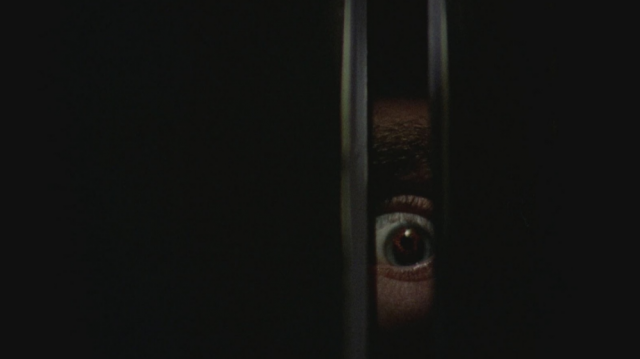
While there’s one particular horror film named after a holiday that usually gets all the attention, it’s not the only film named after a holiday. Hell, it’s not even the first of its kind despite so many slasher films of the late 1970’s and 1980’s taking influence from it. No, before that other holiday film which we’re not going to name here, there was Bob Clark’s 1974 film, Black Christmas. The plot sees a handful of young women spending their Christmas break at their sorority house. Some of the girls leave for the holidays but the ones who stay are tormented by an unknown maniac. The torture begins psychologically with obscene phone calls but soon turns to disappearances and murder. When sorority sister Clare Harrison (Lynne Griffin) goes missing, her friends, Jess (Olivia Hussey), Barb (Margot Kidder), and Phyl (Andrea Martin), are clueless as to what happened to her. Lieutenant Ken Fuller (John Saxon) and his men do their best to find the person targeting the women but he may actually be closer than any of them think.
Now, there’s a lot of debate as to what the first slasher film actually is and there’s a lot of support for Black Christmas in this regard. With films like A Bay of Blood and The Texas Chain Saw Massacre coming before it, there are still a lot of slasher flicks, and other horror titles in general, that owe a debt of gratitude to Clark’s film. After all, it was one of the first films to have a mysterious serial killer stalking young people with a “Final Girl” protagonist standing in his way. There’s also a body count, which is essential in the slasher subgenre. A lot of the things that Black Christmas does may seem clichéd but, in actuality, it’s every other film that’s by-the-numbers since Black Christmas did it all first.
When watching the film here in 2020, it’s quite shocking how much the film got away with. It boasts much stronger language than some of the other early slashers and its kills are more bloody and violent than most as well. Probably the most iconic death of the film, which we won’t ruin here, is so creepy and twisted that it’s absolutely appalling that it made its way into a lot of Black Christmas’s promotional material. Speaking of twisted, the killer doesn’t have the marketability of a Jason Voorhees or Freddy Krueger but his psychotic behavior will have you thinking that maybe you’d rather take your chances with one of the other killers instead. Even though Black Christmas doesn’t quite have the name value of the slasher franchises of the 70’s and 80’s, especially with two awful remake attempts, it’s still a pioneering film in the horror genre. Without it, there’s no way we’d have most of the horror icons we adore today and we especially wouldn’t have that other legendary holiday film.
October 16th: A Nightmare on Elm Street (1984)
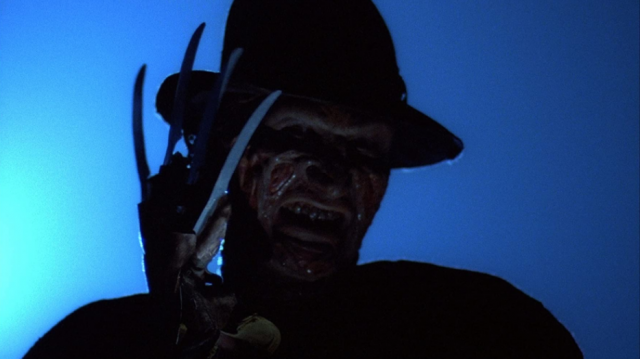
Today, we go from one of the first slasher films ever made to one that changed the game. Of course, horror master Wes Craven outdid himself yet again with 1984’s A Nightmare on Elm Street. A group of teenagers begin having nightmares about Fred Krueger (Robert Englund), a horribly burned man with “knives for fingers” that’s trying to kill them. After a particularly bad nightmare, Tina Gray (Amanda Wyss) asks her friends, Nancy Thompson (Heather Langenkamp) and Glen Lantz (Johnny Depp) to spend the night at her house. Tina’s boyfriend, Rod Lane (Nick Corri), also shows up but none of them are able to hold off Freddy as he begins thinning the herd through their dreams. Nancy remains steadfast as she tries to convince her parents, Marge (Ronee Blakley) and Police Lieutenant Thompson (John Saxon), that she’s not crazy and there truly is a nightmare man stalking her.
For those that haven’t seen the film, shame on you. Also though, there’s no doubt that you’re at least familiar with the character of Freddy Krueger. Since his debut in 1984, he’s become a pop culture horror icon in the same vein of character’s like Frankenstein’s monster and Dracula. There have been numerous sequels, video games, comic books, toys, and every other piece of merchandise you can think of. While Wes Craven wrote the character, Robert Englund is the one that brought Freddy to life. As sequels started to pile up, Freddy became more of a jokester with his witty one liners and his penchant of toying with his prey. In these first few films though, the character was dark, vengeful, and just pure evil. Therefore, it took someone who was a total embodiment of goodness to actually bring him down in this first film. Heather Langenkamp’s Nancy is the perfect Final Girl and probably only second to scream queen Jamie Lee Curtis. Nancy proves to be resourceful in finding ways to escape Freddy and/or coax him out of hiding in her efforts to beat him. She’s the yin to Freddy’s yang and no one does it better than Heather Langenkamp throughout the entire series.
Again, if you haven’t seen A Nightmare on Elm Street, then you really have no business reading this right now. The film is not only one of the best slasher films ever made but also one of the best horror movies in general. With yesterday’s entry, Black Christmas, much of the fear comes from someone actively stalking a group of women in their sorority house. While this is difficult to escape, the events of A Nightmare on Elm Street are virtually impossible because you’re at your most vulnerable when you’re asleep and it’s something that everyone needs to do. The film is full of interesting character arcs and twists that not only make the story riveting but provides a fleshed out cast of characters that’s largely uncommon in the slasher subgenre. Couple this with a master horror filmmaker in Wes Craven and you have a quintessential slasher film that’s required viewing.
October 17th: The Devil’s Rejects (2005)
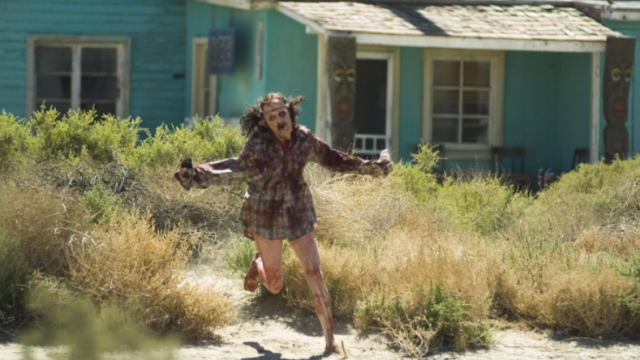
The second, and final, sequel that’s appearing on this list is another instance where you don’t necessarily have to see its predecessor to enjoy it. Rob Zombie’s 2005 opus, The Devil’s Rejects picks up with the Firefly family at a dilapidated farmhouse where Sheriff John Quincy Wydell (William Forsythe) aims to put an end to their murderous rampage. However, Otis B. Driftwood (Bill Moseley) and Baby Firefly (Sheri Moon Zombie) are able to escape the police raid and quickly team up with Captain Spaulding (Sid Haig). The trio embarks on a road trip full of depravity and bloodshed. Though, Sheriff Wydell is always breathing down their necks and isn’t afraid to stoop to the levels of his vile targets.
The Devil’s Rejects is a total coming out party for Zombie as a filmmaker. With his debut film, House of 1000 Corpses, Zombie proved that he could make a movie. In this one, he proves that he’s actually good at making movies. No matter anyone’s opinion about the content of his films, Zombie is truly a phenomenal director even if his screenwriting leaves much to be desired. His attention to detail and eye for shots is incredible and his mastery of his filmmaking craft really began here in The Devil’s Rejects. Whether scenes are taking place in an arid desert, a rundown farmhouse, or a low rent prostitution compound, Zombie presents viewers with a visual feast teeming with personality. This is also the best his characters have ever been. Somehow, Zombie introduces his characters in such a way that new viewers really don’t need to see House of 1000 Corpses to understand who these people are. This is a rare instance in where the audience is following the villains as opposed to their victims. He creates sympathy for these terrible people and provides some surprisingly touching scenes between the trio of Otis, Baby, and Spaulding as well.
While opinions of Zombie’s House of 1000 Corpses are mixed at best, The Devil’s Rejects has become something of a modern horror classic for most genre fans. We really can’t argue that here because this film is definitely Zombie’s best by far. While we love House of 1000 Corpses on this site, it’s not so much an homage to The Texas Chain Saw Massacre as it is a variation of it. Zombie’s Halloween films had moments of brilliance but were too often bogged down by bad scripts and loathsome characters. His later work… well, let’s not even talk about those. The Devil’s Rejects hits a sweet spot. It has all the vulgarity and violence that Zombie’s known for in his work but it also has storytelling, purpose, and heart. The film is a love letter to horror cinema and showcases one of the most original groups of characters the genre has seen in quite some time.
October 18th: The Brood (1979)
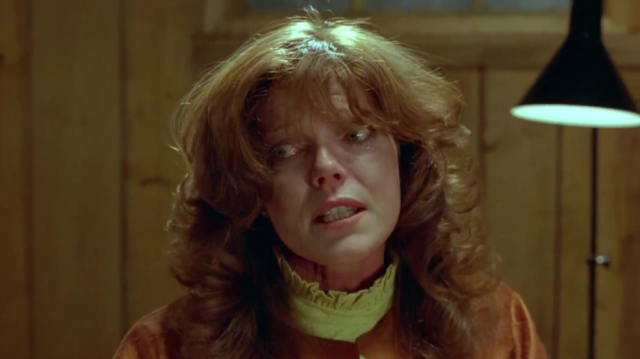
The body horror subgenre is one that doesn’t always get the credit it deserves. This is especially true when it comes to the casual horror fan. Though, if you’re a person looking to get into it, the first place to look is with the master of body horror, David Cronenberg. Whether it’s an early title like 1975’s Shivers or the masterpiece that is 1986’s The Fly, you really can’t go wrong with any of his work. Although the latter film landed on our Top 10 Favorite Horror Films feature last year, we’re going to go back a few years and spotlight an earlier work instead. Cronenberg’s 1979 film, The Brood, centers on Frank Carveth (Art Hindle), a man whose wife, Nola (Samantha Eggar), is being kept in isolation by psychotherapist Hal Raglan (Oliver Reed). Dr. Raglan runs the Somafree Institute where he uses experimental techniques that alter the bodies of his patients in a way to cope with their suppressed mental issues. When Frank notices bruises on his young daughter, Candice (Cindy Hinds), he refuses to allow visitation with his estranged wife. Soon, a series of strange murders occur with all evidence pointing back to Raglan and whatever he’s doing to Nola.
To go into any more detail about The Brood’s plot would be doing a disservice to the film. Let’s just put it this way though, this is a weird one from start to finish. The mystery behind Raglan’s experiments and the connection to the Carveth family drives the plot and commands viewer attention. There’s constant tension and discomfort as you witness these violent murders mixed with the psychological breakdown of Frank’s wife. The film is a slow burn but it’s the good kind of slow burn that often defined 1970’s filmmaking. All of the events are leading to something big and you’re not likely to ever forget The Brood’s eventual payoff.
While it may not be Cronenberg’s best work (again, that honor goes to The Fly), The Brood kicked off an amazing string of body horror gold with both Scanners and Videodrome being released in the following years. In addition, it tackled a number of issues including suppressed childhood, the complete breakdown of the family unit, and the subconscious male fear of the female body. Samantha Eggar’s Nola is something of an unknowing monster that Oliver Reed’s Dr. Haglan awakes. Meanwhile, it’s Art Hindle’s Frank who must navigate the destructive path set before him. This isn’t your typical horror experience full of jump scares and a body count. David Cronenberg’s The Brood is a psychologically deep and satisfyingly bloody affair that opens up a world of discussion and should be considered a must-see in the body horror subgenre.
October 19th: An American Werewolf in London (1981)
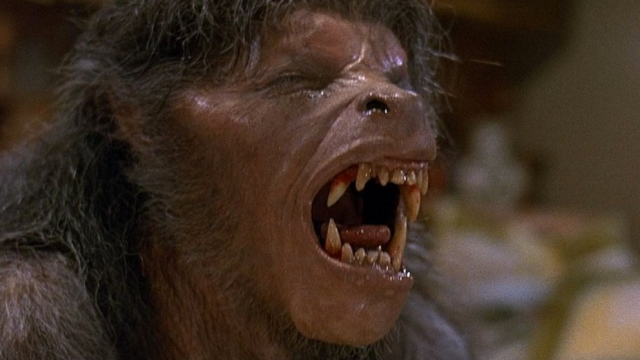
What kind of horror list would this be without a good werewolf movie? While a lot of horror fans will immediately look to the 1941 Lon Chaney Jr. classic, The Wolf Man, as their representative creature feature, we’re going a little more contemporary. John Landis’s 1981 film, An American Werewolf in London opens with David Kessler (David Naughton) and Jack Goodman (Griffin Dunne) backpacking across England. After stopping at a local pub, The Slaughtered Lamb, David and Jack are cast out by unwelcoming patrons. As they walk under a full moon, the duo’s attacked by a vicious creature with Jack being ripped to shreds and David surviving with only a few scratches. The latter wakes up in a London hospital where his mental state deteriorates with visions of his dead friend telling him that he’s going to turn into a werewolf during the next full moon. David’s only support comes from Alex Price (Jenny Agutter), a nurse with whom he begins a relationship. However, the full moon quickly approaches and David’s thirst for blood may be coming with it.
When it comes to 80’s werewolf movies, there’s basically two go-to’s. Coincidentally, An American Werewolf in London and The Howling were released the same year and both continue to be held in high regard among genre fans. The Howling is often tagged as more horror while An American Werewolf in London has moments of levity and even some comedy. Though, the werewolf transformation scene is what lands An American Werewolf in London on this list. It’s truly a sight to behold as one of the most horrifically original effects maybe ever. The work from Rick Baker, arguably one of the best creature effects artists ever, and his team is stunning even to this day. Baker was the very first to win an Academy Award for Best Makeup for his work on this film while adding six more over the course of his career. The satisfyingly bloody effects are an absolute treat for horror fans and easily overshadow the film’s more lighthearted moments.
Essentially, An American Werewolf in London is a modern (at the time in 1981) update on The Wolf Man. A likable lead character is attacked by a werewolf and is forced to become a monster even though he himself is not one. As the lead, David Naughton plays the Lon Chaney Jr. role and makes viewers feel bad for him and his situation. He wants to do the right thing and knows that he may hurt people. His delusions and nightmares continuously haunt him while his only remaining link to humanity is his budding relationship with Jenny Agutter’s Alex. The film is a tragic love story with an innocent man facing an ultimate sacrifice. Mix this with the film’s award winning special effects and you have a cult horror classic that stands the test of time. Though it may not necessarily be the comedy that many claim it to be, especially considering it was written and directed by Animal House’s John Landis, An American Werewolf in London is certainly a horror film. Perhaps unsurprisingly, it’s also one of the best werewolf movies ever and may even be the definitive werewolf experience.
October 20th: The Autopsy of Jane Doe (2016)
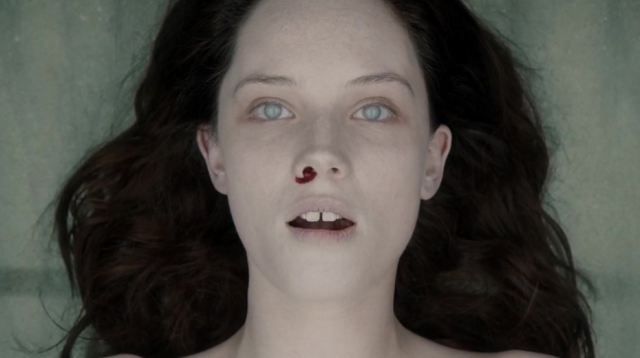
There’s been a lot of blood, guts, and death over the course of our past few entries to the 31 Days of Horror so maybe it’s time to slow things back down. Now, this isn’t to say that there isn’t any spectacle in today’s film but André Øvredal’s The Autopsy of Jane Doe is more spooky mystery thriller than gory murder as we’ve focused on recently. The plot of the film is simple enough with father-son coroner duo, Tommy (Brian Cox) and Austin Tilden (Emile Hirsch), receiving the body of an unidentified woman (Olwen Kelly) at their morgue. Sheriff Burke (Michael McElhatton) tells them that he needs a cause of death on the young woman as soon as possible to piece together what happened at the crime scene she was pulled from. Austin blows off his girlfriend, Emma (Ophelia Lovibond), to assist his father in the autopsy where Austin and Tommy become entwined in a complex mystery to identify their Jane Doe.
The two words that instantly come to mind while watching the film are mood and atmosphere. For most people, dealing with dead bodies isn’t an everyday occurrence. With the two leads being coroners, there’s already an eeriness to the film before it actually tries to scare you. Brian Cox and Emile Hirsch feel natural in their roles and do well enough to ease the early tension given their professions. However, the abnormalities they discover with the body and the secrets that are revealed will chill viewers to the bone. The thrilling visuals and audio will keep you on the edge of your seat and always make you wonder what can possibly happen next. There are plenty of fantastical elements to the story but the script from Ian Goldberg and Richard Naing also keeps bringing the audience back to reality. After all, Tommy and Austin are presented as rational men relying on facts to uncover the gritty details of their subjects.
The best thing about The Autopsy of Jane Doe is its mystery. The visually pristine condition of Jane Doe gives way to some horrific details lurking beneath the skin. What starts out as a routine autopsy for Tommy and Austin turns into a life changing (and threatening) event. The constant uneasiness mixed with familiar, but effective, horror tropes hearkens back to classics like The Shining all way to modern favorites like The Conjuring. The film is basically a detective story that takes place in one main location with only two characters and it still somehow finds a way to make a lasting impact. Some may criticize the ending of the film but it makes sense given the events that Tommy and Austin experience. If you’re looking for a creepy slow burn horror experience, The Autopsy of Jane Doe is a must watch.
That’s it for Part 2! Click here for Part 3!

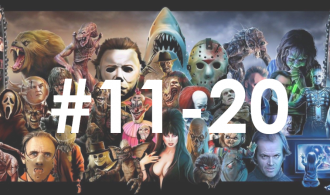
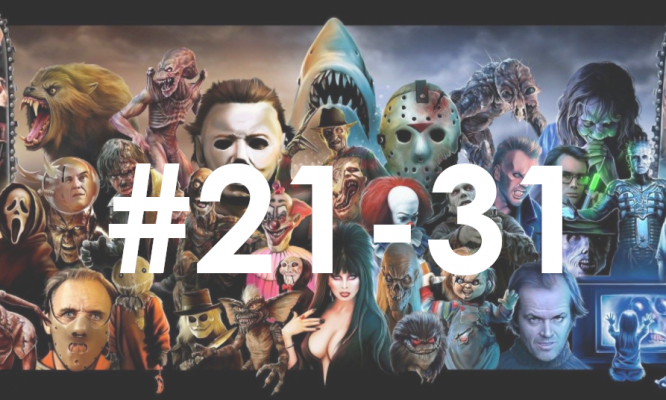
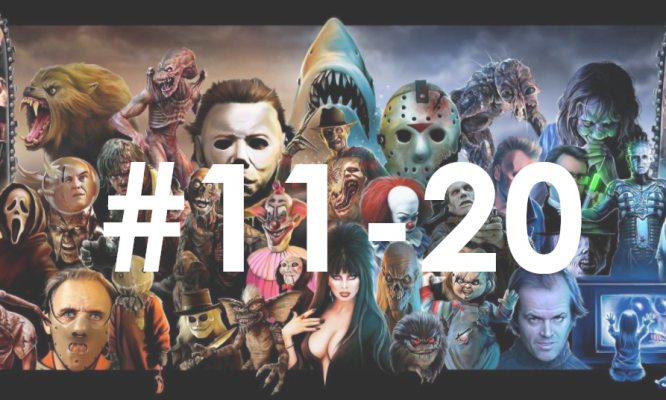
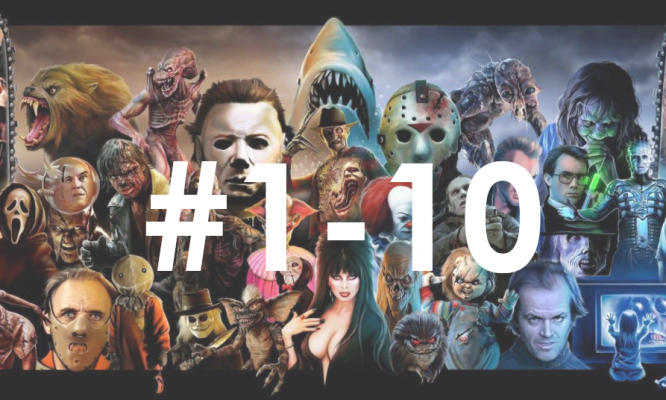
[…] We are officially on the home stretch in the lead up to Halloween with Part 3 of Cinema Smack’s 31 Days of Horror! If you haven’t been following, you can catch up with Part 1 here and Part 2 here. […]
[…] it for Part 1 of our 31 Days of Horror! Click here for Part […]